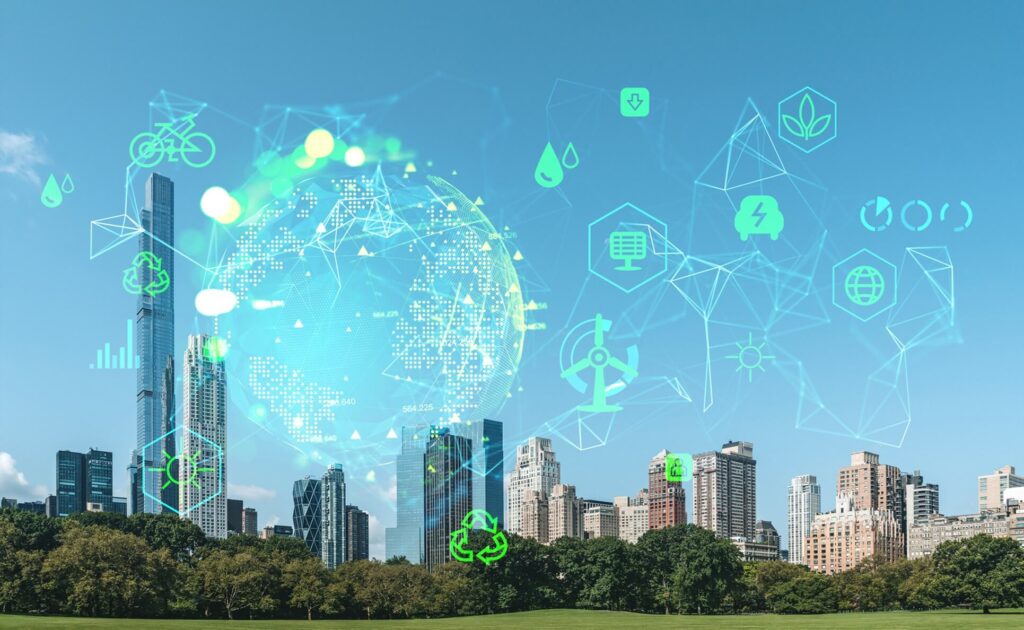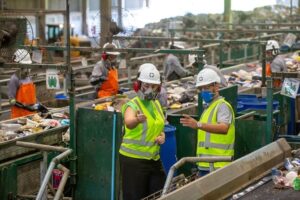
Smart Cities are those that use intelligent software to map local challenges and needs, and then develop alternatives that integrate mobility, sustainability, quality of life, and economy.
Internet of Things and Smart Cities
Smart cities are understood through the rise of the Internet of Things (IoT). In this context, hardware and software are integrated into everyday objects connected to the internet. This connection allows the collection of data about individual and collective behaviors, driving innovation and technological efficiency.
The Internet of Things has substantially changed the way the industry perceives societal patterns and proposes solutions to solve problems. This technology is currently integrated into everything from small everyday conveniences, such as a watch that monitors an individual’s health, to more complex issues like the study of traffic in cities.
Therefore, by integrating individual and collective behavior, IoT enables cities to advance and thrive by meeting the real needs of society, developing Smart Cities.
What are Smart Cities
Smart cities emerged in the 1990s. Using technology, they solve problems in modern cities. This includes issues like lack of security, traffic, inefficiency in services, environmental impacts, education, and quality of life.
Today, we can find various cities around the world that are becoming smarter and transforming the reality of their populations.
A great example is Singapore, a global leader in sustainable development, which launched the Smart Nation program in 2014. This program enabled traffic regulation, the expansion of green areas, sustainable urban planning, as well as efficient urban waste management, carbon emission reduction, and energy efficiency.
To become a smart city, it is necessary to be connected with data technology and have effective governance. This governance should enable collaboration between public management, businesses, and society. Together, they will work on identifying problems, creating, and implementing solutions.
Some characteristics of a smart city include:
- Smart Economy: Encouraging innovation. Using technologies to optimize production processes and promote the circular economy. Digitization of financial services and expansion of e-commerce.
- Smart People: Encouraging public participation in decision-making and social engagement. Investing in education and digital skills for technological inclusion. Using artificial intelligence and data analysis to personalize public services.
- Smart Governance: Transparency in public management. Active participation of the population in political and urban decisions. Using big data and artificial intelligence for digitalization of government services and efficient management.
- Smart Mobility: Efficient, accessible, and sustainable public transportation. Infrastructure for electric and autonomous vehicles. Integration of different modes of transportation with intelligent technologies.
- Smart Environment: Sustainable urban planning with expanded green areas. Use of renewable energy and energy efficiency in buildings. Efficient waste management and encouragement of the circular economy.
- Smart Lifestyle: Enhanced quality of life through the digitalization of services. Connected health with telemedicine and remote patient monitoring. Public safety based on predictive technologies and smart monitoring.
Smart Cities in Brazil
Many Brazilian cities are transforming to digitalize in search of being more efficient, sustainable, secure, and with better quality of life.
Since 2015, Necta and Urban Systems have developed a ranking to elect the Smartest Cities in Brazil, considering those with more than 50,000 inhabitants (656 cities). The Connected Smart Cities Ranking is made up of 74 indicators across 11 thematic areas:
- Urbanism
- Economy
- Education
- Entrepreneurship
- Energy
- Governance
- Mobility
- Safety
- Environment
- Technology & Innovation
- Health
This research is based on the concept of a “connected city,” where development is achieved through the integration of sectors such as sanitation, education, health, economy, and environment.
In 2024, the Brazilian cities that stood out as smart cities were:
- Florianópolis (SC), in 1st place, standing out in areas like technology and innovation, education, bike lanes, health, and safety.
- Vitória (ES) took 2nd place for its governance, health, education, and mobility.
- In 3rd place was São Paulo (SP), which excels in Mobility and Accessibility, especially due to the variety of existing transport modes.
- Curitiba (PR) reached 4th place, standing out in environment, technology and innovation, and governance.
Smart Cities and the Circular Economy
Smart Cities are also allies in developing sustainability practices, especially investing in the circular economy, which is a very important tool, especially for large cities.
When we talk about the circular economy, we must highlight the complexity of tracking a production chain and the culture of disposal. Many companies, governments, and entities face the challenge of structuring a closed chain where everything produced will have the correct disposal.
Therefore, it is through IoT technologies proposed in the Smart Cities model that it is possible to integrate data from industry and society, mapping needs, challenges, and opportunities to propose efficient solutions.
Orizon, a waste valorization company, is an example of how IoT can be used to solve local problems efficiently. Currently, in Brazil, the company offers different waste management services based on regional needs and opportunities.



